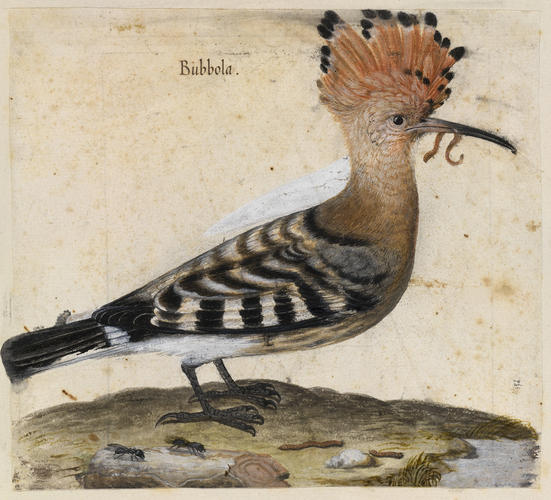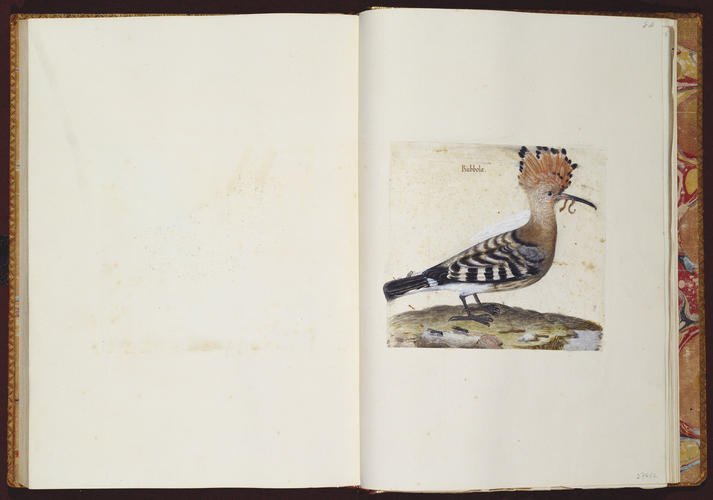-
1 of 253523 objects
Common hoopoe (Upupa epops L.1758) c. 1619–22
Watercolour and bodycolour heightened with gum, over black chalk, the outlines incised; corrections in lead white along upper back. Watermark: fleur de lys in circle surmounted by crown (cut) | 19.0 x 21.5 cm (sheet of paper) | RCIN 927682
-
This natural history drawing from the 'Paper Museum' of Cassiano dal Pozzo (1588–1657) shows the spectacular hoopoe (Upupidae) at slightly less than life size (bird 25–30 cm; drawing 22 cm), with its long, thin, tapering bill, the conspicuous barring of its back and wings, and its exotic orange-coloured crest elevated to display the black and white tipped feathers. The unusually detailed background, showing the bird standing on a grassy bank by a stream, with two carpenter ants (Camponotus sp.) on a piece of dead wood, and two sections of an earthworm (Lumbricus sp.) on the ground and another one hanging from the bird’s bill, indicates the bird’s habitat of bare or lightly vegetated ground, where it forages for its food.
The sheet belongs to a group of bird drawings commissioned by Cassiano from the artist Vincenzo Leonardi to illustrate a 1622 treatise on birds by Giovanni Pietro Olina titled L'Uccelliera, ovvero discorso della natura e proprietà di diversi uccelli ('The Aviary, or Discourse on the Nature and Characteristics of Diverse Birds'). The drawing provided the model for the print in the Uccelliera, though there the posture of the subject was altered to show the bird in a more upright position. The details of the background were also modified to show the winged ants emerging from a tree trunk, and two live earthworms near the stream.
Olina deemed the hoopoe as ‘one of the most beautiful of the indigenous birds in our country’ and described the bird’s crest in detail:
‘[The hoopoe] has on its head a crest of feathers, which it constantly erects and lowers, opening and closing it as it will. It is made of twenty to twenty-five feathers, longer than half a finger, the highest part diminishing in size towards the base of the bill and nape of the neck, and forming a semi-circle. At their tip these feathers are black, white in the middle and at the base chestnut coloured. When it raises its crest it lowers its head’ (Olina 1622, fol. 36) .
The hoopoe is a common summer visitor to Italy, as well as widespread across Europe, Asia and Africa. While European and north Asian birds migrate to the tropics in winter, the African populations are sedentary all year. Olina describes its habitat, and gives an alternative reason to migration for its disappearance at certain times of year:
‘It is found in the country, both in the mountains and in the plains, and sometimes even in main streets and in gardens, where it searches for worms in dung; for this reason it is rarely found in the branches of trees. It is said that every year it moults its feathers, and this is the reason for its not being seen at various times’.
The spectacular and unmistakable appearance of this bird has meant that it has been depicted in art from medieval times onwards – for example, in mosaics at Ravenna, in paintings by Giotto, Pisanello and Giovannino de’ Grassi, and in the Italian ornithological drawings in the Chatsworth collection (on which see R.J.M. Olson and A. Mazzitelli, ‘The discovery of a cache of over 200 sixteenth-century avian watercolours: a missing chapter in the history of ornithological illustration’, Master Drawings xlv, 2007, pp. 435–521). Hoopoes also appear in frescoed ceiling schemes, such as that at the Borghese and Medici villas in Rome.
Annotations: Bubbola.
Engraved: Olina 1622, fol. 35v
Natural History of Birds album (RCIN 970381), fol. 84; laid down on a late eighteenth-century mount sheet (‘type G’ mount). Silhouetted around tip of tail. Trimmed at top.
Text adapted from Birds, Other Animals and Natural Curiosities, Parts B.IV–V of The Paper Museum of Cassiano dal Pozzo: A Catalogue Raisonné, 2 vols, London 2017, cat. 10 [Henrietta McBurney with Carlo Violani].
Provenance
From the ‘Paper Museum’ of Cassiano dal Pozzo (1588–1657) and his brother Carlo Antonio dal Pozzo (1606–89). Sold by Carlo Antonio's grandson to Clement XI Albani, 1703; acquired by Alessandro Albani in 1714, from whom purchased by George III in 1762.
-
Creator(s)
(collector)Acquirer(s)
-
Medium and techniques
Watercolour and bodycolour heightened with gum, over black chalk, the outlines incised; corrections in lead white along upper back. Watermark: fleur de lys in circle surmounted by crown (cut)
Measurements
19.0 x 21.5 cm (sheet of paper)
Markings
watermark: Fleur de lys in circle surmounted by crown (cut)
Other number(s)
RL 27682

